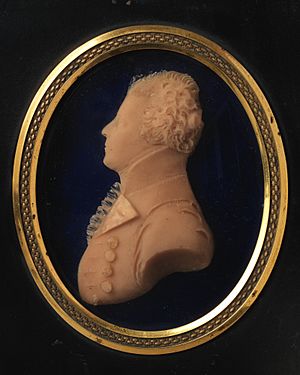Sir Charles Price, 1st Baronet facts for kids
Sir Charles Price, 1st Baronet (born January 25, 1747 – died July 19, 1818), was an important businessman in the City of London. He owned ships, became the Lord Mayor of London, and was also a politician.
Sir Charles Price's Story
Early Life and Business
Charles Price was the son of Reverend Ralph Price. His mother was Sarah Richardson. When he was young, Charles moved to London. He lived with his uncle on Snow Hill.
Charles Price became a successful merchant. He sold rum and brandy. He also owned ships. Four of his ships were used for whaling in the South Seas. Over time, he became very rich. He also worked as an oil merchant and a banker.
On December 16, 1773, Charles Price married Mary Rugge. They were married at St Michael's church in Westminster. Mary brought a lot of money with her into the marriage.
His Political Journey
In 1797, Charles Price was chosen as an alderman. An alderman is a senior member of a city council. He represented the area called Farringdon-Without. In 1799, he served as a sheriff. A sheriff helps keep law and order in the city.
In 1802, he became a Member of Parliament (MP). He was one of four MPs for the City of London. MPs are elected officials who make laws for the country.
In 1803, he achieved a very high position. He became the Lord Mayor of London. This is a very important role in the city. On February 2, 1804, he was given a special title. He became a baronet. This meant he was called "Sir Charles Price, 1st Baronet."
He was elected to Parliament again in 1806 and 1807. However, in 1812, he decided not to run for election again. As an MP, he did not speak much in Parliament. But he strongly supported the government of Prime Minister Pitt.
Sir Charles Price also held many other important roles. He was a magistrate, which is like a judge. He was a Colonel in the Fifth Regiment of Volunteers. He also led the tackle-house and ticket-porters. He was president of the Commercial Traveller's Society.
Later Years
Sir Charles Price passed away on July 19, 1818. He died at his home called Spring-Grove in Richmond. He had been in poor health for a long time.


